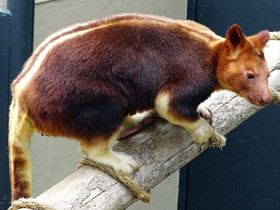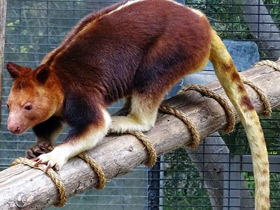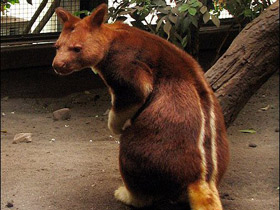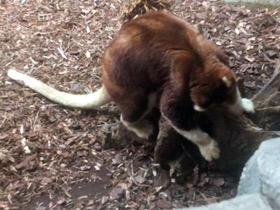Matschie's tree-kangaroo or the Huon tree-kangaroo (Dendrolagus matschiei)
Matschie's tree-kangaroo (Dendrolagus matschiei), also known as the Huon tree-kangaroo is a tree-kangaroo native to the Huon Peninsula of northeastern New Guinea island, within the nation of Papua New Guinea. Under the IUCN classification, Matschie's tree-kangaroo is an endangered species. The scientific name honours German biologist Paul Matschie. The indigenous population refers to it as a Boongarry.
Appearance
Dendrolagus matschiei is a species of marsupial diprotodon of the family Macropodidae endemic to the Huon Peninsula, northeastern New Guinea. It is classified as "endangered" by the IUCN. Its numbers in the wild are less than 2,500. It is scientifically named after the German biologist Paul Matschie, who headed the mammal department of the Berlin Zoological Museum.
The body length of this large kangaroo varies from 55 to 63 cm, its cylindrical tail from 55 to 63 cm and its weight from 9 to 13 kg. Females of Dendrolagus matschiei are heavier and larger than males. The upper body of Dendrolagus matschiei is reddish brown or dark brown, the face, neck and legs are light yellow; the tail is mainly yellow. The body of Dendrolagus matschiei is short and dense, the forelimbs are as long as the hind limbs. Its legs are shorter and broader than those of ground kangaroos, each with thick leather pads and curved claws necessary for climbing. The head of Dendrolagus matschiei is small, as are the ears, but the eyes are large.
The coat of Dendrolagus matschiei is thick and has a hairy "crown" on the back, which allows water to evaporate more quickly from the surface of the body.
Habitat area and lifestyle
Dendrolagus matschiei is endemic to New Guinea. It is found only on the Huon Peninsula, between 1,000 and 3,300 metres above sea level, where it inhabits high altitude, montane rainforests. These agile animals spend most of their lives in trees. They can leap up to 9 metres between branches or jump up to 12 metres to the ground. On the ground, Dendrolagus matschiei prefers to move silently, but in case of danger they can jump at a speed of 4.8 km/h. They are active at night and dusk, and sleep 60% of the time huddled in a tree canopy.
Nutrition
Throughout the day, Dendrolagus matschiei feeds on plant food. Leaves make up the majority of their diet, but they also eat flowers, fruits, nuts, bark, bird and chick eggs, as well as insects. In zoos, Dendrolagus matschiei usually feeds on leaves of fruit trees, apples, carrots, corn, timothy hay, spinach leaves, lettuce and boiled eggs. The diet of Dendrolagus matschiei must necessarily include tea leaves, from which they obtain tannin, which is the substance that gives the shiny colouring of the fur.
Social behaviour and reproduction
These animals lead a solitary lifestyle and are only seen during breeding. Male Dendrolagus matschiei occupy a large territory, which overlaps with smaller territories of females. Dendrolagus matschiei does not have a specific breeding season, although peak breeding usually occurs between October and March.
Pregnancy in Dendrolagus matschiei lasts between 39 and 45 days, which is longer than in all other marsupials. One or two days before parturition, the female moves away from the others and adopts a certain posture: she sits at the base of her tail, with her tail between her legs. The calf is born at just 2.5 cm in size. It takes 2 minutes for it to crawl to its mother's pouch, the way it licked the day before. It then wraps its mouth around the nipple and latches on, and remains in this position for about 100 days. At 250 days after birth, the young Dendrolagus matschiei begins to leave the pouch, at 300 days it can leave it, and at 350 days the young Dendrolagus matschiei is completely independent of its mother. In captivity, Dendrolagus matschiei has a lifespan of more than 20 years.
Threats
In 1996, the IUCN classified the Matschie's tree-kangaroos as endangered animals. A lot of the Huon Peninsula's trees have been cleared in which the tree-kangaroos chiefly inhabit, so there are more grassy areas created and the Matschie's tree-kangaroos’ habitat is being destroyed. They are also threatened by oil drilling, logging, hunting by humans, and rainforest clearing. Some Matschie's tree-kangaroos are hunted by local natives for their meat and fur, while others, such as the people of Yawan, a village in New Guinea, aid in the Matschie's conservation. The people of Yawan have put aside 100,000 acres (400 km2) for the Matschie's preservation.
Threats to existence
The species is endangered due to over-hunting by local people for meat and loss of habitat due to conversion of forest to agricultural land. In addition, the population at the northern end of the mountain range and on the Huon peninsula is growing rapidly, as coffee production is increasing and there is an active nickel mine.




















































